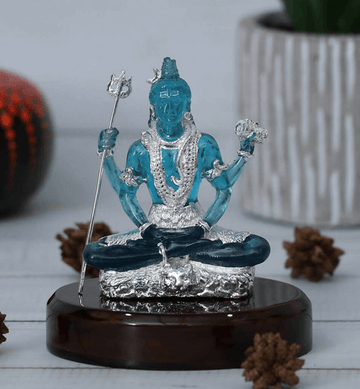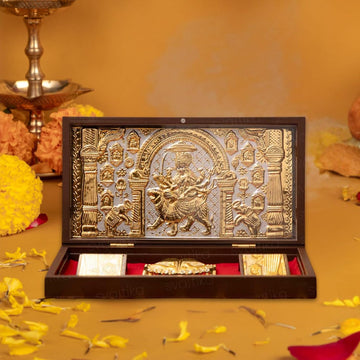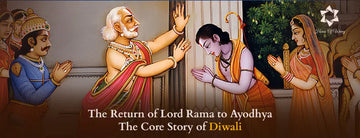Why Nag Panchami Celebrates the Divine Bond with Lord Shiva
“He who holds the serpent as an ornament knows no fear, only divinity.”
Every home where the light of a diya flickers near the Lord Shiva idol begins with the journey of surrender and strength. And this strength is believed to be in the form of a serpent.
A sacred celebration rooted in the Nag Panchami festival goes beyond just worshipping snakes to tributing to the divinity. It reminds us that our fears mask wisdom and may carry the power to heal, protect, and awaken. As Shiva wears Vasuki around his neck, not as a symbol of fear but of faith, on Nag Panchami we embrace these sacred beings of energy and wisdom.
Through this blog, we will discover the spiritual depth and the significance of Nag Panchami through its traditional practices and mythological roots of the timeless bond between Lord Shiva and his serpent, whom he fearlessly embraces.
Why Are Snakes Worshipped in Hinduism?
According to the Vedic worldview, serpents are not considered evil in Hinduism. These are seen as guardians of transformation who carry the essence of birth, cosmic balance, and karmic flow. The Shatapatha Brahmana says they live in the underworld, holding the keys to the divine secrets. In the Upanishads, the coiled snakes are a symbol of kundalini, reflecting the dormant silent energy destined to rise through chakras.
As per the Vastu Shastra, these Nagas are often found in the northeast direction of Lord Shiva idols, guarding the holy spaces in the homes. Astrologically, rituals are practiced on this day to neutralise the karmic energies, like Kaal Sarp Dosh, of these serpents.
The importance of serpents in Hindu culture is more than their physical form, as they embody deep spiritual truths, symbolic meanings, and inner psychological forces.
How Serpents Became Shiva’s Eternal Companions
The connection between Shiva and Nagas portrays one of the iconic figures embodied in the richness of Hinduism. The Shiva’s idols are often carved as calm and detached, yet alive with a snake coiled around his neck.
However, Vasuki is not worn to dominate but to spread a message of overcoming our deep fears. As written in the Shiva Purana, Vasuki reflects ego and death, which all by wearing it around shows his victory over the deepest human limitations. The snake that others dread becomes an ornament on Mahadev, a divine teaching that even our deepest fears can be transformed through wisdom and surrender.
This bond is not a mere symbol but a sacred truth that true divinity reshapes fear into strength, not by denial but by transformation.
Vasuki Naag and Shiva’s Cosmic Role
This bond between Shiva and Vasuki is tied to an act of cosmic service. During the great Samudra Manthan (churning of the ocean), Vasuki was wrapped round Mount Mandara as a rope stretched between devas and asuras tugged in their quest for the tonic to immortality, making him an instrument of transformation.
Vasuki’s offering to endure pain in this cosmic balance made him a celestial hero. And to mark this honour, Lord Shiva made him an eternal companion around his throat, the same throat that held the poison from the ocean’s churning.
Thus, in every Lord Shiva idol, Vasuki reminds us that service, courage, and endurance are as divine as devotion.
Mythology Behind Nag Panchami
So, why is Nag Panchami celebrated? Hindu mythology offers several powerful answers:
- According to the Mahabharata, King Janamejaya made a snake sacrifice to take revenge for his father’s death by Takshaka Naag. This ritual threatened all the serpents, resulting in wiping out all the snakes. However, with the intervention of sage Astika, he halted this yagna, creating a moment of peace over vengeance and giving rise to Nag Panchami.
- In the Krishna Leela, young Krishna danced upon the poisonous Kaliya Naag in the Yamuna, representing a divine act of subduing evil. This leela is celebrated as a central myth behind Nag Panchami, embodying the victory of dharma over adharma.
-
In one of the folk tales this myth was described through a story of a young girl who became a victim of snakebite. Her family’s deep prayers and observance of Nag Panchami Vrat bring her back to life, making her an example of the day’s power to invoke healing.
These stories show that devotion has the power to transform even the wildest forces into protectors of harmony.
Traditions and Tributes on Nag Panchami
The Nag Panchami puja vidhi is performed differently across the varied regions of India, but the core elements remain the same:
-
As a part of the ritual, offerings of milk, saffron, turmeric, and flowers to snake idols are given by devotees.
-
Serpent drawings are created on the walls through haldi and sindoor, honouring the sacred presence of the Nagas.
-
Chanting of mantras such as “Om Namah Shivaya” and “Nag Devta Ki Jai” is practiced on this auspicious day.
-
Fasts (Vrats) are observed for mental clarity and spiritual purification.
In temples, elaborate abhishekams are performed on the idols, often accompanied by cobra worship in India as a central act of devotion.
These Nag Panchami rituals are not superstitions but are symbolic acts of inner awakening and balance.
Regional Variations of Nag Panchami Rituals
Though we all are rooted in the same devotion, every part shows in their cultural way:
-
Kukke Subramanya (Karnataka): Serpent idols buried beneath the ground are worshipped by pilgrims.
-
Trimbakeshwar (Maharashtra): Devotees engage in milk abhishekas on the Shiv Ling and snake idols, honouring purity and divine grace.
-
Kerala & Tamil Nadu: Fasting and prayers are conducted by women to invoke the blessings for fertility and safety of their households.
- Uttar Pradesh & Bihar: Drawings of Nagas are designed in the homes as a belief that it will protect their homes from negativity.
Whether in urban temples or rural homes, these Hindu festivals in Shravan all share one essence: honour, harmony, and connection with the divine.
The Spiritual Meaning Behind Snake Worship
In the yogic traditions, the serpent symbolises a cosmic force called kundalini, which is awakened with the power of chakras, bringing in liberation from all limitations. Shravan month and Nag Panchami are powerful times to activate this inner energy.
Snake worship in Hinduism teaches us to look beyond fear by honouring the divinity even in times of threat. According to Vastu, snakes are considered as the guardians of spirituality in the similar manner that Shiva guards the realms of life and death.
Things to Keep in Mind During Nag Panchami Fast
What to do:
-
Worship and perform the puja rituals before noon.
-
Offer turmeric, milk, and fresh flowers with full devotion.
-
Visit Shiva or Nag Devta temples to let your inner voice reach their ears.
-
Feel the presence of the divine through mantras and meditation.
What to Avoid:
-
Do not engage in activities like digging soil or disturbing anthills.
-
Avoid harming or causing any injury to reptiles or any living being on this holy day.
-
Refrain from meals that are made with onions, garlic, or ingredients of tamsi food.
By performing these Nag Panchami rituals, we align ourselves with the ancient rhythm of reverence and renewal.
Conclusion: A Serpent’s Blessing, A Shiva’s Message
Though Nag Panchami 2025 dates may differ across India, its eternal message remains the same. It tells us that just like divinity can conquer all limitations, we can also dwell upon our fears by embracing Shiva's bond with the serpent.
By honouring this bond and the connection between Shiva and Nagas, we are paying a tribute to nature’s hidden guardians by accepting the fact that change often lies where fear once did.
Bring this eternal harmony into your homes by visiting Wemy and exploring our handcrafted Lord Shiva idols, where each piece is created to honour the grace, power, and fearlessness of Mahadev.










